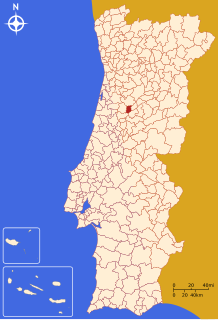Santa Comba Dão
Municipality in Centro, Portugal From Wikipedia, the free encyclopedia
Municipality in Centro, Portugal From Wikipedia, the free encyclopedia
Santa Comba Dão (European Portuguese pronunciation: [ˈsɐ̃tɐ ˈkõbɐ ˈðɐ̃w] ) is a city and a municipality in the Viseu District in Portugal. The population in 2011 was 11,597,[1] in an area of 111.95 km2.[2] The city proper has a population of 3,300.
Santa Comba Dão | |
|---|---|
 Street in Santa Comba Dão | |
 | |
| Coordinates: 40°24′N 8°07′W | |
| Country | |
| Region | Centro |
| Intermunic. comm. | Viseu Dão Lafões |
| District | Viseu |
| Parishes | 6 |
| Government | |
| • President | Leonel Gouveia (PS) |
| Area | |
| • Total | 111.95 km2 (43.22 sq mi) |
| Population (2011) | |
| • Total | 11,597 |
| • Density | 100/km2 (270/sq mi) |
| Time zone | UTC+00:00 (WET) |
| • Summer (DST) | UTC+01:00 (WEST) |
| Local holiday | Ascension Day date varies |
| Website | www |
The present mayor is Leonel Gouveia, elected in 2013 by Socialist Party. The municipal holiday is Ascension Day.
António de Oliveira Salazar, the leader of Portugal from 1932 to 1968 and founder of the Estado Novo, was born in Vimieiro, Santa Comba Dão on 28 April 1889 to a rural family of modest income.
The town's station was formerly a terminus of the Dão line to/from Viseu. This narrow gauge railway opened in 1890 and was closed to passengers in 1988.
Santa Comba Dão was granted city status in 1999. In mid-2000s, a serial killer murdered three young women in the municipality.
Administratively, the municipality is divided into six civil parishes (freguesias):[3]
Seamless Wikipedia browsing. On steroids.
Every time you click a link to Wikipedia, Wiktionary or Wikiquote in your browser's search results, it will show the modern Wikiwand interface.
Wikiwand extension is a five stars, simple, with minimum permission required to keep your browsing private, safe and transparent.